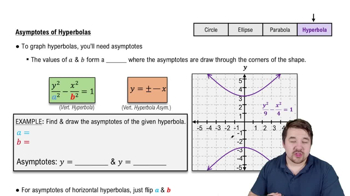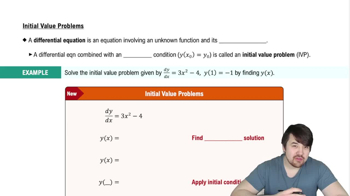Express sinh⁻¹ x in terms of logarithms.
Table of contents
- 0. Functions7h 54m
- Introduction to Functions16m
- Piecewise Functions10m
- Properties of Functions9m
- Common Functions1h 8m
- Transformations5m
- Combining Functions27m
- Exponent rules32m
- Exponential Functions28m
- Logarithmic Functions24m
- Properties of Logarithms36m
- Exponential & Logarithmic Equations35m
- Introduction to Trigonometric Functions38m
- Graphs of Trigonometric Functions44m
- Trigonometric Identities47m
- Inverse Trigonometric Functions48m
- 1. Limits and Continuity2h 2m
- 2. Intro to Derivatives1h 33m
- 3. Techniques of Differentiation3h 18m
- 4. Applications of Derivatives2h 38m
- 5. Graphical Applications of Derivatives6h 2m
- 6. Derivatives of Inverse, Exponential, & Logarithmic Functions2h 37m
- 7. Antiderivatives & Indefinite Integrals1h 26m
- 8. Definite Integrals4h 44m
- 9. Graphical Applications of Integrals2h 27m
- 10. Physics Applications of Integrals 3h 16m
- 11. Integrals of Inverse, Exponential, & Logarithmic Functions2h 34m
- 12. Techniques of Integration7h 41m
- 13. Intro to Differential Equations2h 55m
- 14. Sequences & Series5h 36m
- 15. Power Series2h 19m
- 16. Parametric Equations & Polar Coordinates7h 58m
6. Derivatives of Inverse, Exponential, & Logarithmic Functions
Derivatives of Exponential & Logarithmic Functions
Problem 7.3.13
Textbook Question
11–15. Identities Prove each identity using the definitions of the hyperbolic functions.
cosh 2x = cosh²x + sinh²x (Hint: Begin with the right side of the equation.)
 Verified step by step guidance
Verified step by step guidance1
Start with the right-hand side of the equation: cosh²x + sinh²x.
Recall the definitions of the hyperbolic functions: cosh(x) = (e^x + e^(-x))/2 and sinh(x) = (e^x - e^(-x))/2.
Square both definitions: cosh²x = [(e^x + e^(-x))/2]² and sinh²x = [(e^x - e^(-x))/2]².
Expand the squares: cosh²x = (e^(2x) + 2 + e^(-2x))/4 and sinh²x = (e^(2x) - 2 + e^(-2x))/4.
Add the two results: cosh²x + sinh²x = [(e^(2x) + 2 + e^(-2x)) + (e^(2x) - 2 + e^(-2x))]/4 = (2e^(2x) + 2e^(-2x))/4 = (e^(2x) + e^(-2x))/2, which is the definition of cosh(2x).
 Verified video answer for a similar problem:
Verified video answer for a similar problem:This video solution was recommended by our tutors as helpful for the problem above
Video duration:
1mPlay a video:
Was this helpful?
Key Concepts
Here are the essential concepts you must grasp in order to answer the question correctly.
Hyperbolic Functions
Hyperbolic functions, such as sinh(x) and cosh(x), are analogs of the trigonometric functions but are based on hyperbolas instead of circles. They are defined as sinh(x) = (e^x - e^(-x))/2 and cosh(x) = (e^x + e^(-x))/2. Understanding these definitions is crucial for manipulating and proving identities involving hyperbolic functions.
Recommended video:

Asymptotes of Hyperbolas
Hyperbolic Identities
Hyperbolic identities are equations that hold true for hyperbolic functions, similar to trigonometric identities. One fundamental identity is cosh²(x) - sinh²(x) = 1. Recognizing and applying these identities is essential for proving new identities, such as the one in the question.
Recommended video:

Asymptotes of Hyperbolas
Proof Techniques
Proof techniques in calculus often involve algebraic manipulation, substitution, and the application of known identities. In this case, starting with the right side of the equation and transforming it to match the left side using hyperbolic definitions and identities is a common strategy. Mastery of these techniques is vital for successfully proving mathematical statements.
Recommended video:

Initial Value Problems

 4:50m
4:50mWatch next
Master Derivatives of General Exponential Functions with a bite sized video explanation from Patrick
Start learningRelated Videos
Related Practice
Textbook Question
42
views
